
Microburst
Encyclopedia
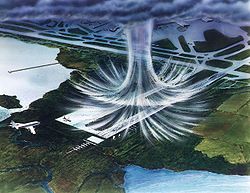
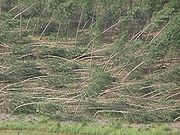
Tornado
A tornado is a violent, dangerous, rotating column of air that is in contact with both the surface of the earth and a cumulonimbus cloud or, in rare cases, the base of a cumulus cloud. They are often referred to as a twister or a cyclone, although the word cyclone is used in meteorology in a wider...
es, which generally have convergent damage. There are two types of microbursts: wet microbursts and dry microbursts. They go through three stages in their life cycle: the downburst, outburst, and cushion stages. The scale and suddenness of a microburst makes it a great danger to aircraft due to the low-level wind shear
Wind shear
Wind shear, sometimes referred to as windshear or wind gradient, is a difference in wind speed and direction over a relatively short distance in the atmosphere...
caused by its gust front, with several fatal crashes having been attributed to the phenomenon over the past several decades.
A microburst often has high winds that can knock over fully grown trees. They usually last for a duration of a couple of seconds to several minutes.
History of term
The term was defined by senior weather expert Tetsuya Theodore Fujita as affecting an area 4 km (2.5 mi) in diameter or less, distinguishing them as a type of downburstDownburst
A downburst is created by an area of significantly rain-cooled air that, after reaching ground level, spreads out in all directions producing strong winds. Unlike winds in a tornado, winds in a downburst are directed outwards from the point where it hits land or water...
and apart from common wind shear
Wind shear
Wind shear, sometimes referred to as windshear or wind gradient, is a difference in wind speed and direction over a relatively short distance in the atmosphere...
which can encompass greater areas. Fujita also coined the term macroburst for downbursts larger than 4 km (2.5 mi), a scale of size known as the mesoscale.
A distinction can be made between a wet microburst which consists of precipitation and a dry microburst which consists of virga
Virga
In meteorology, virga is an observable streak or shaft of precipitation that falls from a cloud but evaporates before reaching the ground. At high altitudes the precipitation falls mainly as ice crystals before melting and finally evaporating; this is usually due to compressional heating, because...
. They generally are formed by precipitation-cooled air rushing to the surface, but they perhaps also could be powered from the high speed winds of the jet stream
Jet stream
Jet streams are fast flowing, narrow air currents found in the atmospheres of some planets, including Earth. The main jet streams are located near the tropopause, the transition between the troposphere and the stratosphere . The major jet streams on Earth are westerly winds...
deflected to the surface in a thunderstorm
Thunderstorm
A thunderstorm, also known as an electrical storm, a lightning storm, thundershower or simply a storm is a form of weather characterized by the presence of lightning and its acoustic effect on the Earth's atmosphere known as thunder. The meteorologically assigned cloud type associated with the...
(see downburst
Downburst
A downburst is created by an area of significantly rain-cooled air that, after reaching ground level, spreads out in all directions producing strong winds. Unlike winds in a tornado, winds in a downburst are directed outwards from the point where it hits land or water...
).
Microbursts are recognized as capable of generating wind speeds higher than 75 m/s (168 mph; 270 km/h).
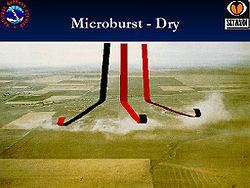
Dry microbursts
When rain falls below cloud base or is mixed with dry air, it begins to evaporate and this evaporation process cools the air. The cool air descends and accelerates as it approaches the ground. When the cool air approaches the ground, it spreads out in all directions and this divergence of the wind is the signature of the microburst. High winds spread out in this type of pattern showing little or no curvature are known as straight-line winds.Dry microbursts, produced by high based thunderstorms that generate little surface rainfall, occur in environments characterized by a thermodynamic profile exhibiting an inverted-V at thermal and moisture profile, as viewed on a Skew-T log-P thermodynamic diagram. Wakimoto (1985) developed a conceptual model (over the High Plains of the United States
United States
The United States of America is a federal constitutional republic comprising fifty states and a federal district...
) of a dry microburst environment that comprised three important variables: mid-level moisture, a deep and dry adiabatic lapse rate in the sub-cloud layer, and low surface relative humidity.
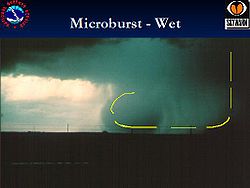
Wet microbursts
Wet microbursts are downbursts accompanied by significant precipitation at the surface which are warmer than their environment (Wakimoto, 1998). These downbursts rely more on the drag of precipitation for downward acceleration of parcels than negative buoyancy which tend to drive "dry" microbursts. As a result, higher mixing ratios are necessary for these downbursts to form (hence the name "wet" microbursts). Melting of ice, particularly hail, appears to play an important role in downburst formation (Wakimoto and Bringi, 1988), especially in the lowest one kilometer above ground level (Proctor, 1989). These factors, among others, make forecasting wet microbursts a difficult task.| Characteristic | Dry Microburst | Wet Microburst |
|---|---|---|
| Location of Highest Probability within the United States | Midwest/West | Southeast |
| Precipitation | Little or none | Moderate or heavy |
| Cloud Bases | As high as 500 mb | Usually below 850 mb |
| Features below Cloud Base | Virga Virga In meteorology, virga is an observable streak or shaft of precipitation that falls from a cloud but evaporates before reaching the ground. At high altitudes the precipitation falls mainly as ice crystals before melting and finally evaporating; this is usually due to compressional heating, because... |
Shafts of strong precipitation reaching the ground |
| Primary Catalyst | Evaporative cooling | Downward transport of higher momentum |
| Environment below Cloud Base | Deep dry layer/low relative humidity/dry adiabatic lapse rate | Shallow dry layer/high relative humidity/moist adiabatic lapse rate |
| Surface Outflow Pattern | Omni-directional | Gusts of the direction of the mid-level wind |
Development stages of microbursts
The evolution of downbursts is broken down into three stages: the contact stage, the outburst stage and the cushion stage.Physical processes of dry and wet microbursts
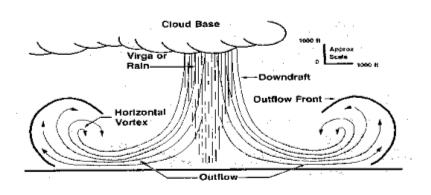
Simple explanation
In the case of a wet microburst, the atmosphere is warm and humid in the lower levels and dry aloft. As a result, when thunderstorms develop, heavy rain is produced but some of the rain evaporates in the drier air aloft. As a result the air aloft is cooled thereby causing it to sink and spread out rapidly as it hits the ground. The result can be both strong damaging winds and heavy rainfall occurring in the same area. Wet downbursts can be identified visually by such features as a shelf cloud, while on radar they sometimes produce bow echoes.In the case of a dry microburst, the atmosphere is warm but dry in the lower levels and moist aloft. Thus when showers and thunderstorms develop, most of the rain evaporates before reaching the ground.
Basic physical processes using simplified buoyancy equations
Start by using the vertical momentum equationPrimitive equations
The primitive equations are a set of nonlinear differential equations that are used to approximate global atmospheric flow and are used in most atmospheric models...

By decomposing the variables into a basic state and a perturbation, defining the basic states, and using the Ideal Gas Law (
 ), then the equation can be written in the form
), then the equation can be written in the form
where B is used to denote buoyancy. Note that the virtual temperature correction usually is rather small and to a good approximation, it can be ignored when computing buoyancy. Finally, the effects of precipitation loading on the vertical motion are parameterized by including a term that decreases buoyancy as the liquid water mixing ratio (
 ) increases, leading to the final form of the parcel's momentum equation:
) increases, leading to the final form of the parcel's momentum equation:
The first term is the effect of perturbation pressure gradients on vertical motion. In some storms this term has a large effect on updrafts (Rotunno and Klemp, 1982) but there is not much reason to believe it has much of an impact on downdrafts (at least to a first approximation) and therefore will be ignored.
The second term is the effect of buoyancy on vertical motion. Cleary, in the case of microbursts, one expects to find that B is negative meaning the parcel is cooler than its environment. This cooling typically takes place as a result of phase changes (evaporation, melting, and sublimation). Precipitation particles that are small, but are in great quantity, promote a maximum contribution to cooling and, hence, to creation of negative buoyancy. The major contribution to this process is from evaporation.
The last term is the effect of water loading. Whereas evaporation is promoted by large numbers of small droplets, it only takes a few large drops to contribute substantially to the downward acceleration of air parcels. This term is associated with storms having high precipitation rates. Comparing the effects of water loading to those associated with buoyance, if a parcel has a liguid water mixing ration of 1.0 gkg−1, this is roughly equivalent to about 0.3 K of negative buoyancy; the latter is a large (but not extreme) value. Therefore, in general terms, negative buoyancy is typically the major contributor to downdrafts.
Negative vertical motion associated only with buoyancy
Using pure "parcel theory" results in a prediction of the maximum downdraft of
where NAPE is the Negative Available Potential Energy,

and where LFS denotes the Level of Free Sink for a descending parcel and SFC denotes the surface. This means that the maximum downward motion is associated with the integrated negative buoyancy. Even a relatively modest negative buoyancy can result in a substantial downdraft if it is maintained over a relatively large depth. A downward speed of 25 m/s results from the relatively modest NAPE value of 312.5 m²s−2. To a first approximation, the maximum gust is roughly equal to the maximum downdraft speed.

Danger to aircraft
The scale and suddenness of a microburst makes it a great danger to aircraft, particularly those at low altitude which are taking off and landing. The following are some fatal crashes and/or aircraft incidents that have been attributed to microbursts in the vicinity of airports:- A BOACBoacBoac may refer to:* Boac, Marinduque, a municipality in the Southern Philippines* Boac , an American rapper* British Overseas Airways Corporation, a former British state-owned airline...
Canadair C-4 (G-ALHE), Kano Airport - 24 June 1956. - A MALÉV Ilyushin Il-18Ilyushin Il-18The Ilyushin Il-18 is a large turboprop airliner that became one of the best known Soviet aircraft of its era as well as one of the most popular and durable, having first flown in 1957 and still in use over 50 years later. The Il-18 was one of the world's principal airliners for several decades...
(HA-MOC), Copenhagen AirportCopenhagen AirportCopenhagen Airport is the main international airport serving Copenhagen, Denmark and the Oresund Region. It is located on the island of Amager, south of Copenhagen city centre, and west of Malmö city centre on the other side of the Oresund Bridge. The airport lies mainly in the municipality...
– 28 August 1971. - Eastern Air Lines Flight 66Eastern Air Lines Flight 66Eastern Air Lines Flight 66, a Boeing 727-225 with registration number N8845E, departed from New Orleans Moisant Field, bound for John F. Kennedy International Airport on the afternoon of June 24, 1975. The aircraft carried 124 persons, including 116 passengers and 8 crew.As the aircraft was on its...
Boeing 727Boeing 727The Boeing 727 is a mid-size, narrow-body, three-engine, T-tailed commercial jet airliner, manufactured by Boeing. The Boeing 727 first flew in 1963, and for over a decade more were built per year than any other jet airliner. When production ended in 1984 a total of 1,832 aircraft had been produced...
-225(N8845E), John F. Kennedy International AirportJohn F. Kennedy International AirportJohn F. Kennedy International Airport is an international airport located in the borough of Queens in New York City, about southeast of Lower Manhattan. It is the busiest international air passenger gateway to the United States, handling more international traffic than any other airport in North...
– 24 June 1975 - Pan Am Flight 759Pan Am Flight 759Pan Am Flight 759, operated by a Boeing 727-235, N4737 Clipper Defiance, was a regularly scheduled passenger flight from Miami to Las Vegas, with an en route stop at New Orleans...
Boeing 727Boeing 727The Boeing 727 is a mid-size, narrow-body, three-engine, T-tailed commercial jet airliner, manufactured by Boeing. The Boeing 727 first flew in 1963, and for over a decade more were built per year than any other jet airliner. When production ended in 1984 a total of 1,832 aircraft had been produced...
-235 (N4737), New Orleans International AirportLouis Armstrong New Orleans International AirportLouis Armstrong New Orleans International Airport is a Class B public use international airport in Jefferson Parish, Louisiana, United States. It is owned by the City of New Orleans and is located 10 nautical miles west of its central business district. The airport's address is 900 Airline Drive...
– 9 July 1982 - Delta Air Lines Flight 191Delta Air Lines Flight 191Delta Air Lines Flight 191 was an airline service from Fort Lauderdale, Florida's Fort Lauderdale-Hollywood International Airport, bound for Los Angeles International Airport in Los Angeles, California, by way of Dallas-Fort Worth International Airport...
Lockheed L-1011 TriStar (N726DA), Dallas-Fort Worth International AirportDallas-Fort Worth International AirportDallas/Fort Worth International Airport is located between the cities of Dallas and Fort Worth, Texas, and is the busiest airport in the U.S. state of Texas...
– 2 August 1985 - Martinair Flight 495 McDonnell DouglasMcDonnell DouglasMcDonnell Douglas was a major American aerospace manufacturer and defense contractor, producing a number of famous commercial and military aircraft. It formed from a merger of McDonnell Aircraft and Douglas Aircraft in 1967. McDonnell Douglas was based at Lambert-St. Louis International Airport...
DC-10 (PH-MBN), Faro AirportFaro Airport-Incidents and accidents:*On 21 December 1992, Martinair Flight 495 skidded off the runway in bad weather at Faro Airport killing 54 passengers and two crew out of a total of 340 people on board....
– 21 December 1992 - USAir Flight 1016USAir Flight 1016USAir Flight 1016 was a regularly scheduled flight between Columbia, South Carolina and Charlotte, North Carolina. On Saturday, July 2, 1994, the plane, a McDonnell Douglas DC-9 registered N954VJ, departed Columbia Metropolitan Airport at 18:15 EST...
Douglas DC-9 (N954VJ), Charlotte/Douglas International AirportCharlotte/Douglas International AirportCharlotte Douglas International Airport is a joint civil-military public international airport located in Charlotte, North Carolina. Established in 1935 as Charlotte Municipal Airport, in 1954 the airport was renamed Douglas Municipal Airport after former Charlotte mayor Ben Elbert Douglas, Sr...
– 2 July 1994 - Goodyear Blimp GZ-20A (N1A, "Stars and Stripes"), Coral Springs, FloridaCoral Springs, FloridaCoral Springs, officially chartered July 10, 1963, is a city in Broward County, Florida, United States, approximately northwest of Fort Lauderdale. As of the 2010 United States Census, the city had a population of 121,096...
– 16 June 2005
A microburst often causes aircraft to crash when they are attempting to land (the above-mentioned BOAC and Pan Am flights are notable exceptions). The microburst is an extremely powerful gust of air that, once hitting the ground, spreads in all directions. As the aircraft is coming in to land, the pilots try to slow the plane to an appropriate speed. When the microburst hits, the pilots will see a large spike in their airspeed, caused by the force of the headwind created by the microburst. A pilot inexperienced with microbursts would try to decrease the speed. The plane would then travel through the microburst, and fly into the tailwind, causing a sudden decrease in the amount of air flowing across the wings. The decrease in airflow over the wings of the aircraft causes a drop in the amount of lift produced. This decrease in lift combined with a strong downward flow of air can cause the thrust required to remain at altitude to exceed what is available.
Danger to buildings
- On September 8, 2011, at 5:01 PM, a dry microburst hit Nellis AFB, NevadaNevadaNevada is a state in the western, mountain west, and southwestern regions of the United States. With an area of and a population of about 2.7 million, it is the 7th-largest and 35th-most populous state. Over two-thirds of Nevada's people live in the Las Vegas metropolitan area, which contains its...
causing several aircraft shelters to collapse. Multiple aircraft were damaged and eight people were injured.
- On September 22, 2010 in the Hegewisch neighborhood of ChicagoChicagoChicago is the largest city in the US state of Illinois. With nearly 2.7 million residents, it is the most populous city in the Midwestern United States and the third most populous in the US, after New York City and Los Angeles...
, a wet microburst hit, causing severe localized damage and localized power outages, including fallen-tree impacts into at least four homes. No fatalities were reported.
- On September 16, 2010, just after 5:30 PM, a wet macroburst [a more extensive downburstDownburstA downburst is created by an area of significantly rain-cooled air that, after reaching ground level, spreads out in all directions producing strong winds. Unlike winds in a tornado, winds in a downburst are directed outwards from the point where it hits land or water...
than a microburst] with winds of 125mph hit parts of Central QueensQueensQueens is the easternmost of the five boroughs of New York City. The largest borough in area and the second-largest in population, it is coextensive with Queens County, an administrative division of New York state, in the United States....
in New York CityNew York CityNew York is the most populous city in the United States and the center of the New York Metropolitan Area, one of the most populous metropolitan areas in the world. New York exerts a significant impact upon global commerce, finance, media, art, fashion, research, technology, education, and...
, causing extensive damage to trees, buildings and vehicles in an area 8 miles long and 5 miles wide. Approximately 3,000 trees were knocked down by some reports. There was one fatality when a tree fell onto a car on the Grand Central ParkwayGrand Central ParkwayThe Grand Central Parkway is a parkway that stretches from the RFK-Triborough Bridge in New York City to Nassau County on Long Island. At the Queens-Nassau border, it becomes the Northern State Parkway, which runs across the northern part of Long Island through Nassau County and into Suffolk...
.
- On June 24, 2010, shortly after 4:30 PM, a wet microburst hit the city of Charlottesville, VirginiaCharlottesville, VirginiaCharlottesville is an independent city geographically surrounded by but separate from Albemarle County in the Commonwealth of Virginia, United States, and named after Charlotte of Mecklenburg-Strelitz, the queen consort of King George III of the United Kingdom.The official population estimate for...
. Field reports and damage assessments show that Charlottesville experienced numerous down bursts during the storm, with wind estimates at over 75 miles per hour. In a matter of minutes, trees and downed power lines littered the roadways. A number of houses were hit by trees. Immediately after the storm, up to 60,000 Dominion Power customers in Charlottesville and surrounding Albemarle County were without power.
- On June 11, 2010, around 3:00 AM, a wet microburst hit a neighborhood in southwestern Sioux Falls, SD. It caused major damage to four homes, all of which were occupied. No injuries were reported. Roofs were blown off of garages and walls were flattened by the estimated 100 mph winds. Cost of repairs could be $500,000 or more.
- On May 2, 2009, the lightweight steel and mesh building in IrvingIrving, TexasIrving is a city located in the U.S. state of Texas within Dallas County. According to the 2010 U.S. Census, the city population was 216,290. Irving is within the Dallas–Plano–Irving metropolitan division of the Dallas–Fort Worth–Arlington metropolitan area, designated...
, TexasTexasTexas is the second largest U.S. state by both area and population, and the largest state by area in the contiguous United States.The name, based on the Caddo word "Tejas" meaning "friends" or "allies", was applied by the Spanish to the Caddo themselves and to the region of their settlement in...
used for practice by the Dallas CowboysDallas CowboysThe Dallas Cowboys are a professional American football franchise which plays in the Eastern Division of the National Football Conference of the National Football League . They are headquartered in Valley Ranch in Irving, Texas, a suburb of Dallas...
football team was flattened by a microburst, according to the National Weather Service.
- On March 12, 2006, a microburst hit LawrenceLawrence, KansasLawrence is the sixth largest city in the U.S. State of Kansas and the county seat of Douglas County. Located in northeastern Kansas, Lawrence is the anchor city of the Lawrence, Kansas, Metropolitan Statistical Area, which encompasses all of Douglas County...
, KansasKansasKansas is a US state located in the Midwestern United States. It is named after the Kansas River which flows through it, which in turn was named after the Kansa Native American tribe, which inhabited the area. The tribe's name is often said to mean "people of the wind" or "people of the south...
. 60 percent of the University of KansasUniversity of KansasThe University of Kansas is a public research university and the largest university in the state of Kansas. KU campuses are located in Lawrence, Wichita, Overland Park, and Kansas City, Kansas with the main campus being located in Lawrence on Mount Oread, the highest point in Lawrence. The...
campus buildings sustained some form of damage from the storm. Preliminary estimates put the cost of repairs at between $6 million and $7 million.
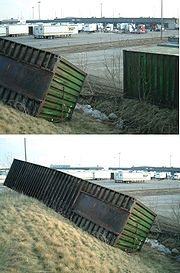
See also
- List of notable microbursts
- Air safetyAir safetyAir safety is a term encompassing the theory, investigation and categorization of flight failures, and the prevention of such failures through regulation, education and training. It can also be applied in the context of campaigns that inform the public as to the safety of air travel.-United...
- Concordia (ship)Concordia (ship)Concordia was a steel-hulled barquentine that was built in Poland in 1992 for the West Island College, Montreal, Canada. She served as a sail training ship until she capsized and sank on 17 February 2010.-Description:...
- Downdraft
- Vertical draftVertical draftAn updraft or downdraft is the vertical movement of air as a weather related phenomenon. One of two forces causes the air to move. Localized regions of warm or cool air will exhibit vertical movement. A mass of warm air will typically be less dense than the surrounding region, and so will rise...
- Low level windshear alert systemLow level windshear alert systemA Low level windshear alert system measures wind speed and direction at remote sensor station sites situated around an airport.Each equipped airport may have as few as 6 or as many as 32 remote anemometer stations. The remote sensor data received is transmitted to a master station, which generates...
(LLWAS) - Planetary boundary layerPlanetary boundary layerThe planetary boundary layer , also known as the atmospheric boundary layer , is the lowest part of the atmosphere and its behavior is directly influenced by its contact with a planetary surface. On Earth it usually responds to changes in surface forcing in an hour or less...
(PBLPlanetary boundary layerThe planetary boundary layer , also known as the atmospheric boundary layer , is the lowest part of the atmosphere and its behavior is directly influenced by its contact with a planetary surface. On Earth it usually responds to changes in surface forcing in an hour or less...
) - Convective storm detectionConvective storm detectionConvective storm detection is the meteorological observation of deep, moist convection and consists of detection, monitoring, and short-term prediction. This term includes the minority of storms which do not produce lightning and thunder. Convective storms can produce tornadoes as well as large...
Printed media
- Fujita, T.T.Ted Fujitawas a prominent severe storms researcher. His research at the University of Chicago on severe thunderstorms, tornadoes, hurricanes and typhoons revolutionized knowledge of each.- Biography :Fujita was born in Kitakyūshū, Fukuoka Prefecture, Japan...
(1981). "Tornadoes and Downbursts in the Context of Generalized Planetary Scales". Journal of the Atmospheric SciencesJournal of the Atmospheric SciencesThe Journal of the Atmospheric Sciences is a scientific journal published by the American Meteorological Society...
, 38 (8). - Wilson, James W. and Roger M. Wakimoto (2001). "The Discovery of the Downburst - TT Fujita's Contribution". Bulletin of the American Meteorological SocietyBulletin of the American Meteorological SocietyThe Bulletin of the American Meteorological Society is a scientific journal published by the American Meteorological Society.The official organ of the society, it is devoted to editorials, topical reports to members, articles, professional and membership news, conference announcements, programs and...
, 82 (1).
External links
- The Semi-official Microburst Handbook Homepage (NOAA)
- Taming the Microburst Windshear (NASANASAThe National Aeronautics and Space Administration is the agency of the United States government that is responsible for the nation's civilian space program and for aeronautics and aerospace research...
) - Microbursts (University of WyomingUniversity of WyomingThe University of Wyoming is a land-grant university located in Laramie, Wyoming, situated on Wyoming's high Laramie Plains, at an elevation of 7,200 feet , between the Laramie and Snowy Range mountains. It is known as UW to people close to the university...
) - Forecasting Microbursts & Downbursts (Forecast Systems LaboratoryForecast Systems LaboratoryThe Forecast Systems Laboratory was a meteorological research and development laboratory in the National Oceanic and Atmospheric Administration /Office of Oceanic and Atmospheric Research...
)

